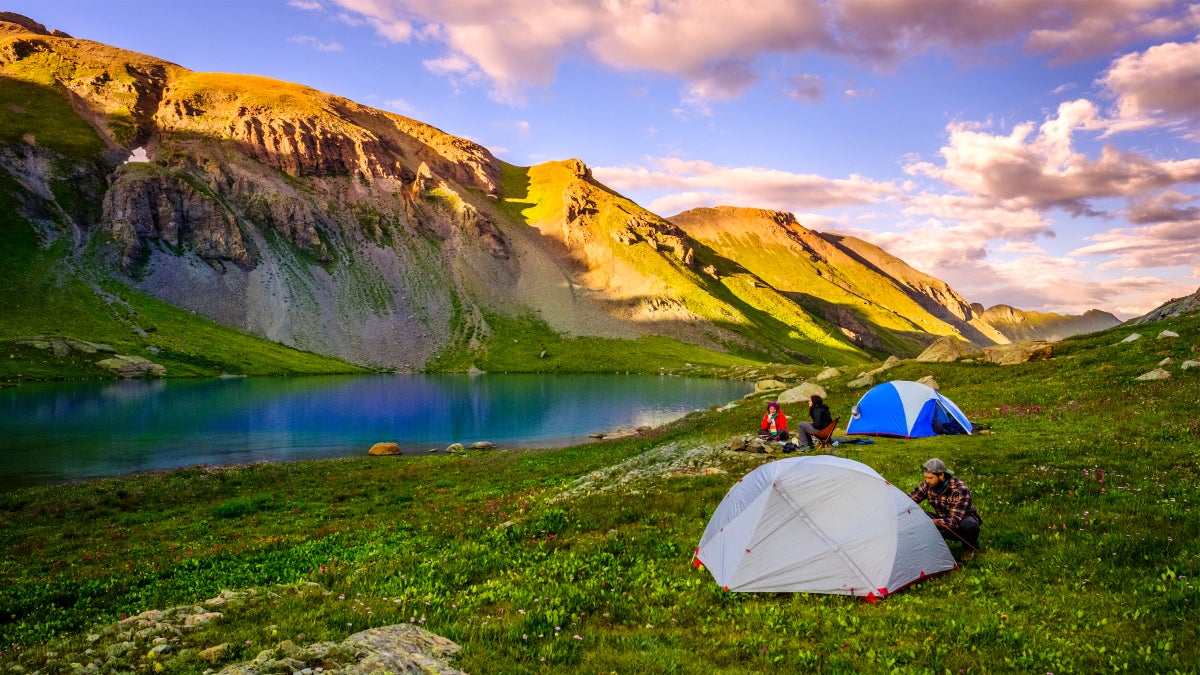Products You May Like
Get full access to Outside Learn, our online education hub featuring in-depth fitness, nutrition, and adventure courses and more than 2,000 instructional videos when you sign up for Outside+
Sign up for Outside+ today.
Whether you’re headed out for a quick overnight or trekking the Continental Divide for several months, your tent is the first line of defense between you and the elements. From weight to wind resistance, dozens of factors play into finding the right tent for your adventure. To help narrow down the search for this big-ticket piece of gear, we’ve highlighted our current favorite three-season backpacking tents, along with helpful tips for sizing up your potential home away from home.
Looking for something more specialized? Check out our favorite ultralight shelters and tarp-tents and our top winter/mountaineering tents.
What to Look For in a Backpacking Tent
Weight
As one of the heaviest items you’ll carry on your trip, nothing cuts pack weight like an ultralight shelter. There are inevitably tradeoffs to dropping weight, which typically include a higher price tag, less durable materials, less interior space, and a non-freestanding pitch. Try to find the lightest tent that still meets all of your other requirements.
Livability
Yes, you’ll want to buy a tent that fits however many people you plan on hiking with—but there’s so much more to sizing a shelter. Many solo hikers will still bring a two-person tent for the extra space and to keep gear inside. Some tents cut weight by narrowing dimensions, especially at the foot of the shelter, which could be a no-go for your non-cuddly camp-mates. If you are tall or need more space in general, be sure to check length before choosing a tent. If you tend to hike in stormy climes, a generous peak height makes passing time in your shelter that much more pleasant.
Double- or Single-Walled
Most conventional three-season backpacking tents are double-walled—meaning they have a dedicated inner mesh body, pole structure, and external rainfly. They tend to breathe much better than single-walled tents and therefore reduce condensation buildup. The downside? They’re usually heavier than single-walled tents, which use a single waterproof or water-resistant body fabric.
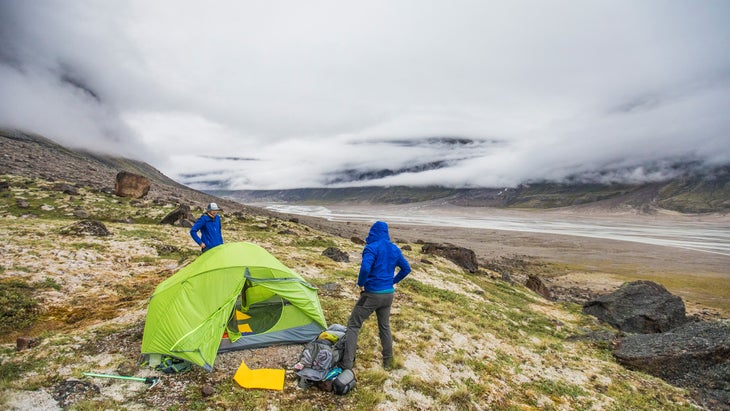
Pitch Style
Freestanding tents don’t need to be staked out. That’s an important feature when camping in areas with solid rock ledge or loose sand, where sinking a stake may not be an option. Semi-freestanding tents often require only two stakes on one end, while non-freestanding shelters often require four to six stakes for a proper pitch. Some tents, especially non-freestanding ones, also have a bigger footprint, which means slotting into narrow campsites might be difficult.
Weather Resistance
Design and material choice will affect how well the best backpacking tents stand up to heavy winds and precipitation. There’s no easy way to divine how well a tent will hold up to the elements on paper, so testing it out on a short shakedown trip is always a good idea. That said, tents with higher profiles tend to be more impacted by wind, and, while they are technically stronger than aluminum poles, carbon poles are more likely to snap under stress rather than bending. Tall bathtub floors and a rainfly that extends all the way to the ground will aid in keeping water from splashing into your tent.
Durability
In most nylon and polyester tents, you’ll see a denier specification, which is a measurement of the fabric’s weight and thickness. Lightweight tents tend to use a lighter denier (denoted by a lower number) and are more prone to punctures and tears. Tent floors tend to have a higher denier to protect against ground abrasions, but you might want to invest in a groundsheet regardless if your tent is particularly fragile. Dyneema is an ultra-lightweight alternative to commonly used sil-nylon in tents, but is extremely expensive and still prone to punctures despite its strength.
Our top picks at a glance:
Best All-Around: Sea to Summit Telos TR2
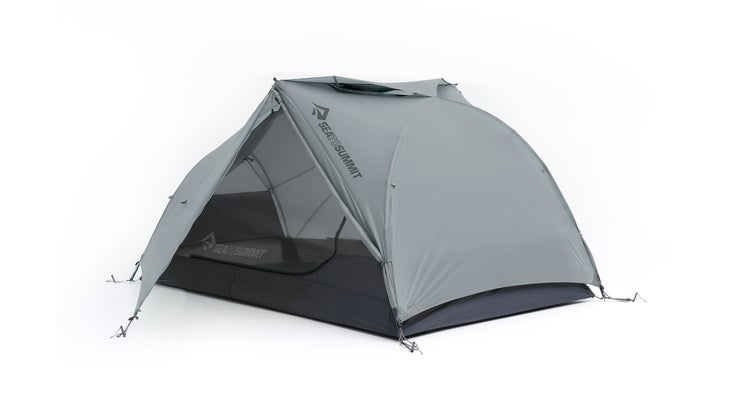
Price: $559
Weight: 3 lbs. 11 oz.
Buy Now
✅ Pros: Strong, weatherproof, excellent interior space
❌ Cons: Heavy, Expensive
If the devil is in the details, then this is the most unholy tent we’ve ever occupied. Nothing, it seems, escaped the attention of legendary tent designer Jake Lah, who collaborated with Sea to Summit for this two-person, freestanding tent. Naturally (since Lah is the guy behind DAC poles), it all starts with the structure. The single, multi-hubbed pole has an inverted V-shape top section that creates twin peaks and props up near-vertical walls. The design equates to a ton of livable space inside, while still being tensioned enough to prevent water from pooling atop the sil/PeU fly and strong enough to shrug off 25-mph winds when we camped at treeline in Colorado’s Indian Peaks Wilderness. —Backpacker Editors
Lightest Freestanding: Big Agnes Tiger Wall 2 Platinum
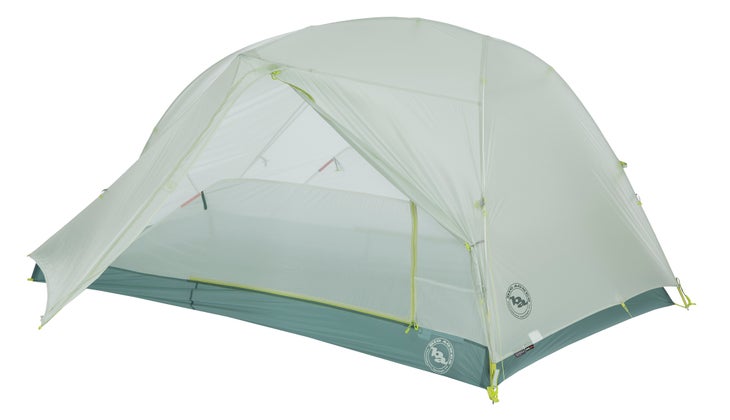
Price: $600
Weight: 2 lbs. 4 oz.
Buy Now
✅ Pros: Very lightweight for a freestanding tent, full-featured
❌ Cons: Expensive
When it comes to freestanding tents, designing one to weigh 2 pounds or less is a bit like breaking the four-minute mile. The Tiger Wall 2 Platinum is the first two-person tent we’ve tested to flirt with the 2 pound benchmark that doesn’t also have a handful of drawbacks. Some critical attributes? Two doors, two vestibules, double-wall construction, and a hassle-free pitch. The generous 28-square-foot interior left plenty of room for two, while the 8-square-foot vestibules sheltered a pack and boots. While the Tiger Wall needs to be staked out at the foot for a taut pitch, it’s a breeze to move around when selecting a campsite. The tent had excellent breathability thanks to a full mesh body, and a hubbed-pole system held up to 25-mph winds and rain in Nevada’s Lahontan State Recreation Area. Yes, it’s pricey. But for a fully-featured, self-supporting tent that weighs less than many one-person shelters, it’s a worthy splurge. —Eli Bernstein
Looking for more ultralight tents, tarptents, and shelters? Check out our 6 best right here.
Best for Casual Backpackers: REI Co-op Half Dome SL2+
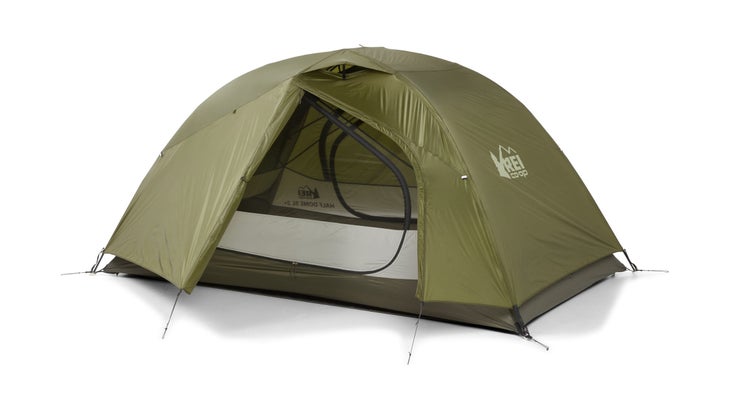
Price: $279
Weight: 3 lbs. 15 oz.
Buy Now
✅ Pros: Affordable, spacious, full-featured
❌ Cons: Heavy
The Half Dome SL 2+ is our choice for the best combination of price, spaciousness, ease of setup, and durability. Costing less than $300, it boasts 35.8 square feet of floor space, two 11.3- square-foot vestibules, and a 42-inch peak height. “I’m 5’11” and I had plenty of headroom and space to sprawl out,” one tester said after a weekend in Big Dominguez Canyon, Colorado. “It’s extremely livable for two, and you could even squeak in a dog.” Two closeable ceiling vents and plenty of mesh in the upper tent body keep air moving, and our testers experienced no condensation during 35°F nights in western Colorado. The Half Dome offers ample interior storage for headlamps, phones, and other small items in its six pockets—one at each bottom corner, and two up top. The interior stayed dry during passing storms. —Will McGough
Best Space-to-Weight Ratio: Nemo Dragonfly 3P
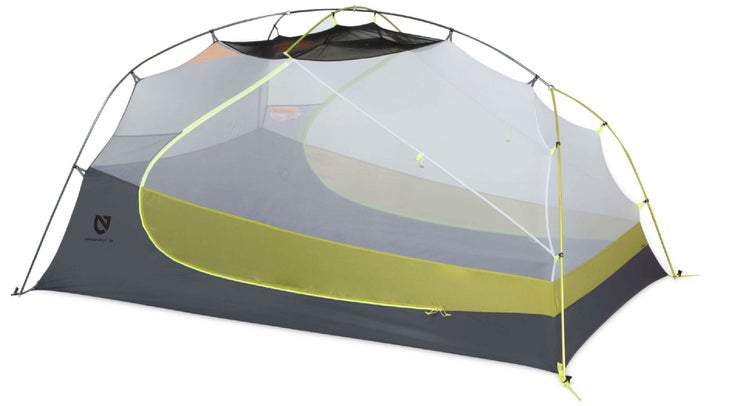
Price: $530
Weight: 3 lbs. 15 oz.
Buy Now
✅ Pros: Lightweight for a 3-person tent, spacious
❌ Cons: Tapered interior can be tight for wide or large sleeping pads
Opulent and ultralight aren’t usually mentioned in the same breath, but with the Dragonfly you can have both. “With an average width of more than 65 inches and near-vertical walls, three won’t be a crowd. But because it’s so light, I often carried it as an extra-roomy two-person tent when camping with my girlfriend,” one tester says. The tent’s 41 square feet of floor space is plenty of room for three to spread out if you do pack it to capacity, and two 10-square-foot vestibules can stash gear for the group. Setup is a breeze with a single, hubbed pole. —WM
Best Budget: Sierra Designs Tabernash 2
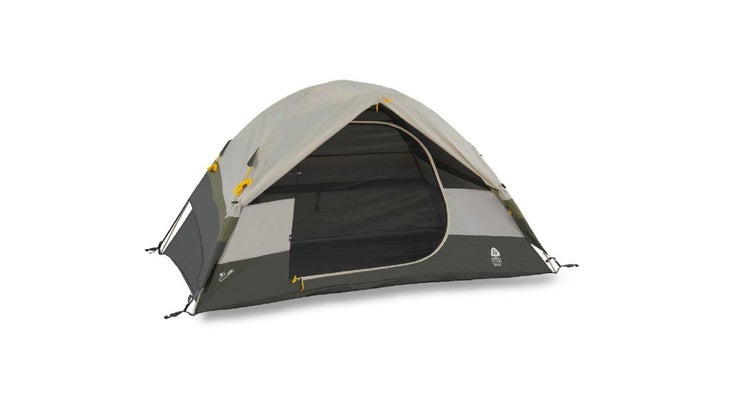
Price: $100
Weight: 6 lbs. 4 oz.
Buy Now
✅ Pros: Very affordable
❌ Cons: Very heavy
If you’ve ever been frustrated that “budget-friendly” tents cost around $200, Sierra Designs would like to have a word. Its new double-walled shelter is only $100, and for the price, there’s a lot to like: At 6.2 pounds, the Tabernash is relatively light for a frontcountry tent (it packs to 20 inches by 5 inches, and you could probably push it into easy backcountry duty), and a single large, D-shape mesh door aids in ventilation. The tent’s 48-inch peak height is generous for a shelter of its size, and our testers were able to change clothes and perform camp tasks inside. —WM
Best Protection: Hillenberg Helags 3
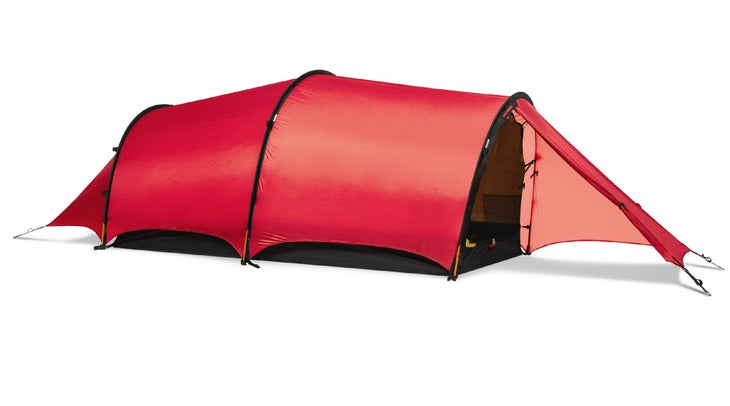
Price: $1065
Weight: 5 lbs. 12 oz.
Buy Now
✅ Pros: Very weatherproof, spacious
❌Cons: Very expensive, heavy
The price tag on the double-walled Helags 3 will definitely sting. But, its excellent strength-to-weight ratio and ability to withstand weather and the test of time might make the sticker shock easier to swallow, especially for those who regularly camp in nasty weather and unfriendly terrain. This shelter uses Hilleberg’s proprietary silicone-coated material known as Kerlon—one of the strongest tent fabrics on the market—in its fly (the inner is made from DWR-treated, 10-denier ripstop nylon). Once properly staked out (the pitch is bomber, with three DAC poles, six guy-outs, and 16 stakes) the tube-shaped Helags can stand up to the toughest summer storms. “Wind from all directions just rolls over its low-profile shape, and the pitch stood firm in strong, 30-mph gusts in Colorado’s Book Cliffs area,” one tester says. The Helags has a 40-square-foot floor, the end walls are vertical, and its sides are near-vertical, creating comfortable space for three sleepers. Two 14-square-foot vestibules hold gear for a trio. —WM
Best Tent for Families: Klymit Maxfield 4
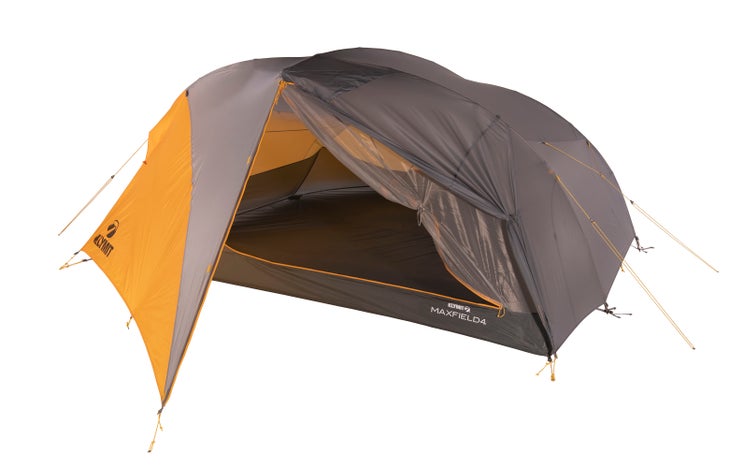
Price: $500
Weight: 5 lbs. 9 oz.
Buy Now
✅ Pros: Very lightweight for a 4 person tent, easy to pack
❌ Cons: Small interior
The Maxfield is one of the lightest four-person shelters out there, making it great for family trips that tend to be heavy on gear. Its 53-square-foot floor is slightly smaller than average, but still fits four standard sleeping pads (everyone can sleep facing the same direction). Two huge mesh ceiling pockets at the head and foot are ideal for organizing a family’s-worth of stuff. Bonus: “Instead of a standard stuff sack, the Maxfield rolls up fast into a burrito-style bag,” said one tester after a group outing to Colorado’s 10,007-foot Kebler Pass. “Just throw everything on it and roll it up. No stuffing or folding required.” —Heather Balogh Rochfort
Honorable Mentions
Exped Lyra II
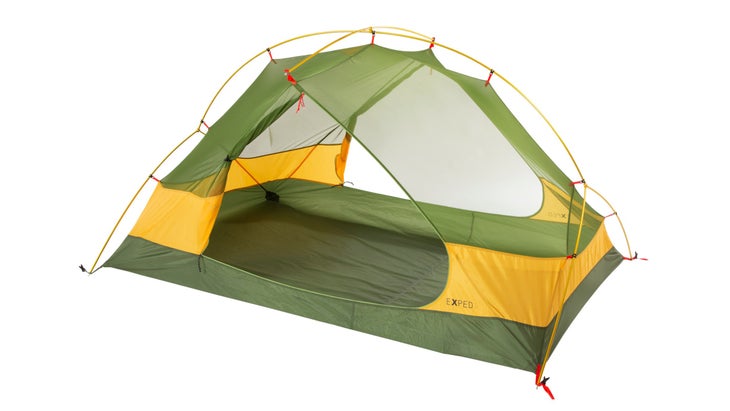
Price: $279
Weight: 4 lbs. 4 oz.
Pitch the Lyra II wherever you want—credit the multi-hubbed pole and 68-denier polyester fly and floor for the bulletproof design. This double-wall, freestanding shelter kept us dry through bouts of heavy rain, ice, snow, and 25-mph gusts during a storm on New York’s Finger Lakes Trail. —HBR
Marmot Superalloy 2P
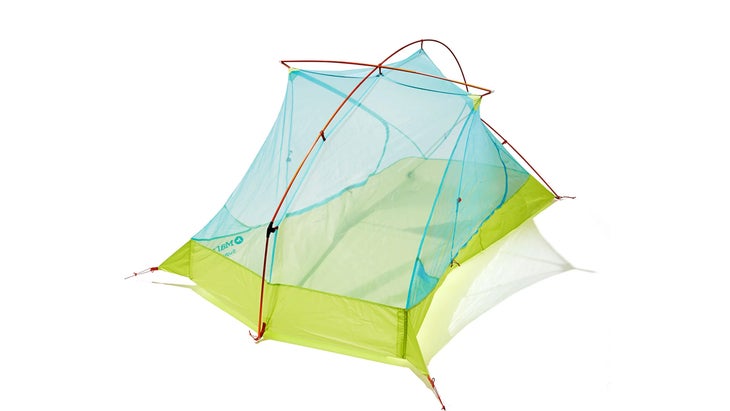
Price: $429
Weight: 2 lbs. 11 oz.
The Superalloy achieves an attractive trifecta: livable, lightweight, and affordable (for an ultralight shelter), making it a good pick for minimalist hikers on a budget. Its 28-square-foot floor fit two 6-foot testers thanks to an 87-inch length and nearly vertical walls, and two 6.5-square-foot vestibules each fit a pack apiece. —HBR
Mountain Hardwear Mineral King 3
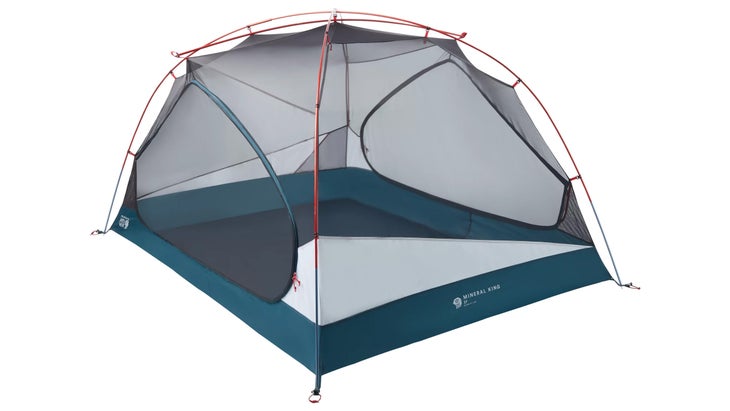
Price: $350
Weight: 7 lbs. 1 oz.
When a tent is an all-around solid performer and has eco cred to match, it’s a keeper. The Mineral King impressed us with its oversize doors, all-mesh walls and rollback fly for stargazing, and balance between weight and price and doesn’t use toxic fire-retardant compounds commonly found in tents. —HBR
Nemo Aurora 2
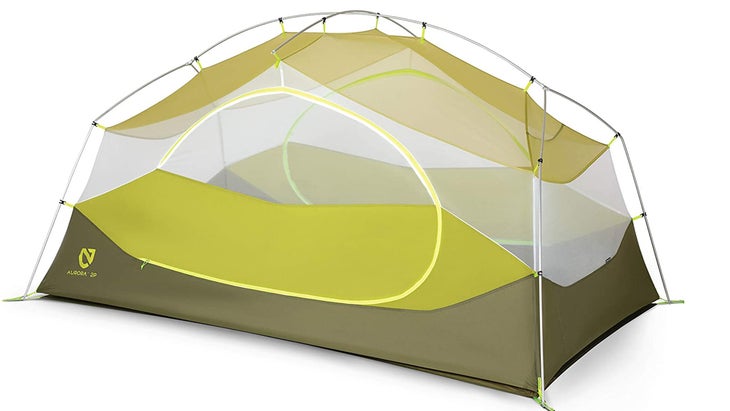
Price: $250
Weight: 4 lbs. 9 oz.
For backpackers who would rather tax their backs than their wallets, the double-wall Aurora is a can’t-miss choice. Its above-average, 32-square-foot floor feels palatial, and vertical walls expand the roominess. The Aurora’s price also includes a footprint (7.8 ounces) for pitches on rough terrain. —HBR
Klymit Cross Canyon 2
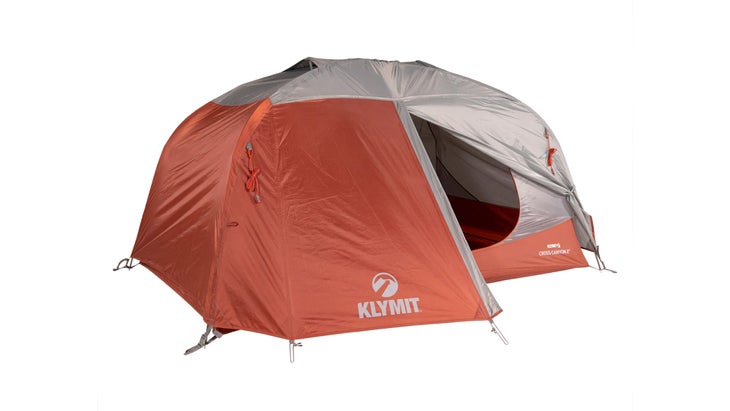
Price: $200
Weight: 5 lbs. 6 oz.
With its combination of breathability, ample storage options, and affordability, the double-walled Cross Canyon is a great pick for car-camping duos who want to occasionally head into the backcountry. —WM
The Best Backpacking Tent For You
Heading out on your first overnight or multi-night trip? Err on the spacious side by bringing a two-person tent rather than a one-person. Having all of your gear inside the tent with you is a huge convenience. You can always slim down to a spartan one-person tent if the extra space isn’t worth the weight penalty.
If you primarily go car camping or only take the occasional, short backpacking trip, choosing a roomy, affordable tent makes plenty of sense, as long as it’s light enough to carry in your pack (less than 5 pounds is a good benchmark for a two-person tent) and protects you from the elements.
Bringing a dog? Up your tent size by a full person or risk becoming a human dog bed. Make sure to choose a tent with a thick, durable floor to avoid punctures from your pup’s claws.
If your regular backpacking destinations are particularly rocky or sandy, consider investing in a freestanding tent—you may not be able to drive stakes into the ground.
What a Backpacker Editor Looks For in a Backpacking Tent
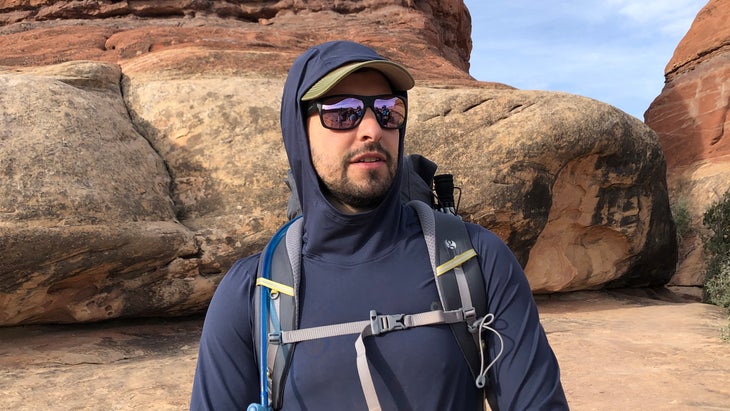
Benjamin Tepler, Assistant Gear Editor
“As someone who’s experienced my fair share of broken poles, torn rainflies, and hole-ridden tent floors, I prize durability above everything else. High-denier material in the body and fly, along with a stable, well-reinforced pole structure, helps me sleep at night.”
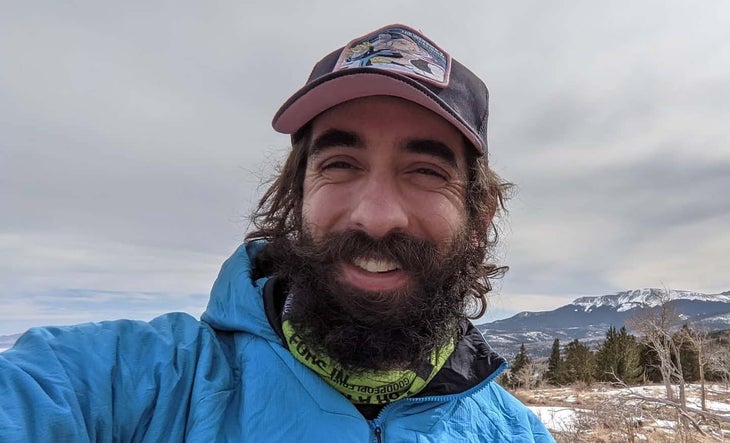
Adam Roy, Senior Digital Editor
“These days, I spend a lot of time camping with either my toddler son or my perpetually-anxious Chihuahua, so I gravitate toward budget tents that I don’t have to stress about wearing out. Yeah, they’re a little heavier, but both of my backpacking buddies have little legs, so I can’t hike that fast anyway.”
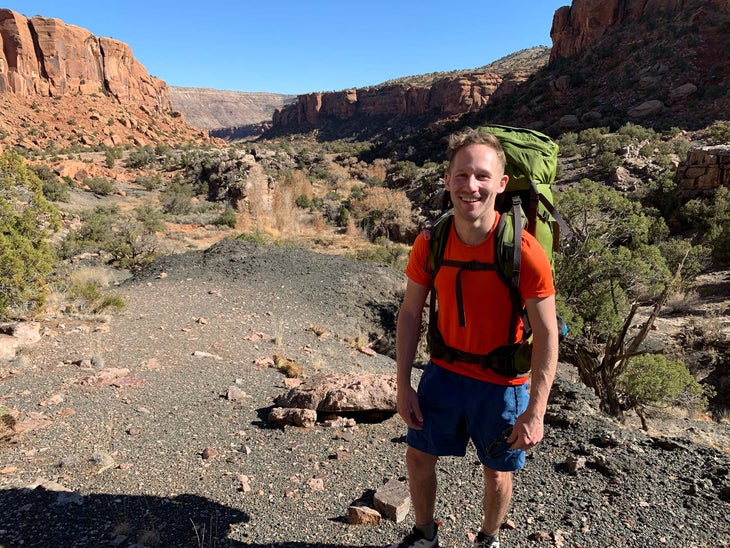
Eli Bernstein, Senior Gear Editor
“I’m all about space-to-weight ratio, so I seek out roomy tents that don’t weigh too much. This often means that I make concessions to price and durability, but I put those out of my mind as I fall to sleep with plenty of room for me, my hiking partner, and gear inside my palace. If I can, I will usually take a light three-person tent for a two-person trip to maximize headroom.”
